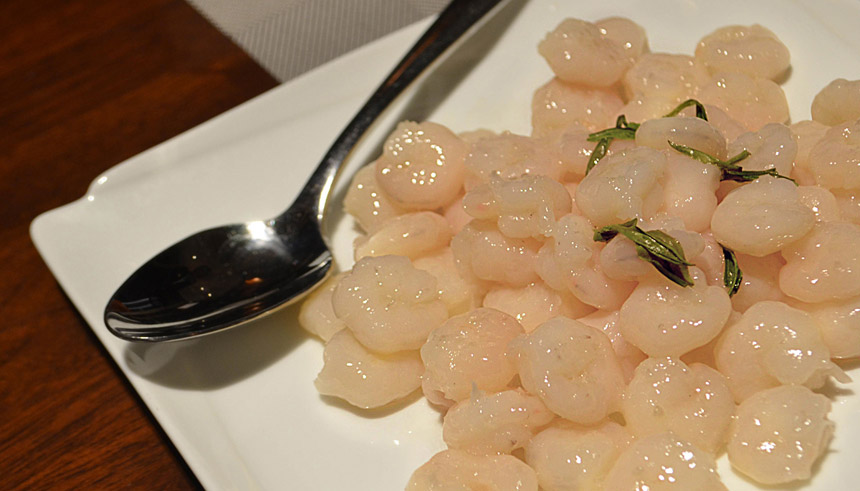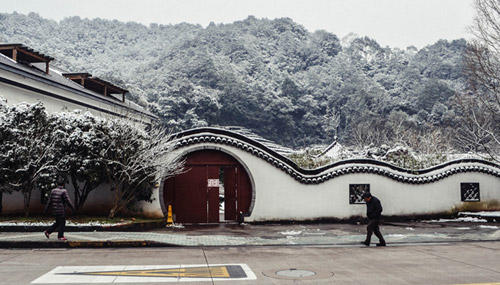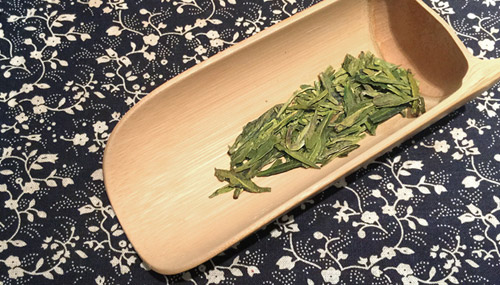East West Lifestyle
Recipes of China: Longjing Tea Shrimp From Hangzhou
By Clarissa Wei

How the signature dish remains constant in a changing city.
I was convinced that the moment I got to Hangzhou, rows of tea shrubs and a giant, omnipresent lake would greet me. In my mind, I had equated Hangzhou with nature, peace and tranquillity. It’s what I needed, after spending a considerable amount of time in stressful Shanghai. Hangzhou is the capital of the Zhejiang province of China. Historically, it was the capital of the Southern Song dynasty. During that time, it was a center for trade and a residence for the elite. Tea was one of the cornerstones of society. It was an activity that the literati participated in and was often enjoyed in the midst of nature.
But when I arrived, I was surprised to see that Hangzhou was yet another modern, 21st-century city. Tall, sweeping buildings, chain stores and hordes of traffic greeted me. While a lake and tea fields indeed existed, what I was looking for was sectioned off in a very specific part of town. In many ways, Hangzhou is a microcosm for modern China. The activity is all in the city; historical sites and nature are but an afterthought. The irony, however, is that it’s the latter that’s promoted in the tourism material.
In the last couple of years, the city of Hangzhou has earned a reputation for being one of China’s high-tech hubs. E-commerce giant Alibaba Group Holding Ltd. is housed there and there’s a burgeoning startup scene chock-full of young millennials vying for a chunk of the pie. None of the people I was meeting knew, really, how to cook or how to recite a recipe.

"In many ways, Hangzhou is a microcosm for modern China."
Still, I tried not to get discouraged, and when the weather was warm enough, I’d make my way toward the lake and walk around. Eventually, a friend connected me with a nearby hotel that bordered the lake and we spent an afternoon with the staff sipping green tea culled from nearby fields. I became acquainted with the chef there, who gave me his recipe for a plate of Longjing tea shrimp.
Longjing tea is the signature brew of Hangzhou. Longjing (which translates to Dragon Well) is the village in Hangzhou most known for its green tea; it’s become a major tourism draw. The tea itself imparts a roasted, slightly nutty flavor, and quite a few chefs use it in savory dishes. When I visited in February, the tea trees were covered in snow. The end of March and early April is the best time to buy tea in Hangzhou. This is when the leaves are freshly picked, and unlike oolong or pu’erh, green tea is best consumed as soon as possible.

In Hangzhou, the shrimp are sourced from Lake Tai. They’re tiny river shrimp and have a naturally sweet flavor. These shrimp, of course, aren’t available outside of China, so I’ve substituted peeled baby shrimp for Lake Tai shrimp in the recipe.
Marinating the shrimp in cornstarch and a bit of salt draws out the flavors and, lastly, they are doused in tea water and decorated with bright green tea leaves. Although river shrimp can be found all throughout China’s southern seaboard, only in Hangzhou are they cooked with tea. The shrimp serve as a canvas to highlight Hangzhou’s most prized home-grown product – green tea.
Here’s the recipe:
Longjing Tea Shrimp
Prep and cooking time: 5 hours
Servings: 3
Ingredients:
- 1 pound peeled baby shrimp
- 2 tablespoons cornstarch + extra for dusting
- 1 tablespoon salt
- 3 egg whites
- Canola oil
- 1 tablespoon Longjing green tea leaves
- 1/4 cup water
- Sprinkling of MSG
- 3 tablespoons dashi powder
- Dust shrimp with cornstarch and a drizzle of water. Toss it around in a bowl and let it sit for 2 hours. Then pat dry with a paper towel.
- Next, marinate it in two tablespoons of cornstarch, the salt and the egg whites. Drizzle some canola oil over the mixture. Wrap with plastic wrap and put it in a cool, dry place. Marinate for at least 2 hours.
- Take a wok and turn up the heat to low. Drizzle the wok with canola oil and cook the shrimp for 2 minutes. Take the shrimp out and set aside.
- Prepare the tea by steeping it in a 1/4 cup of hot water. Steep for 3 minutes and then filter the tea. Keep the tea water and leaves.
- Add the shrimp back to the wok, and quickly add the tea water and a dash of salt. Stir gently and then turn off heat.
- Transfer to the shrimp to a plate. Garnish with tea leaves.
Hungry for more? Follow Clarissa’s journey through China as she uncovers authentic dishes and cultural insight.
Sign up for the Reach Further Newsletter
We’ll keep you in the know about the latest US-Asia business news and trends.
Suscríbase al boletín Reach Further
Lo mantendremos informado sobre las últimas noticias y tendencias comerciales entre Estados Unidos y China.

